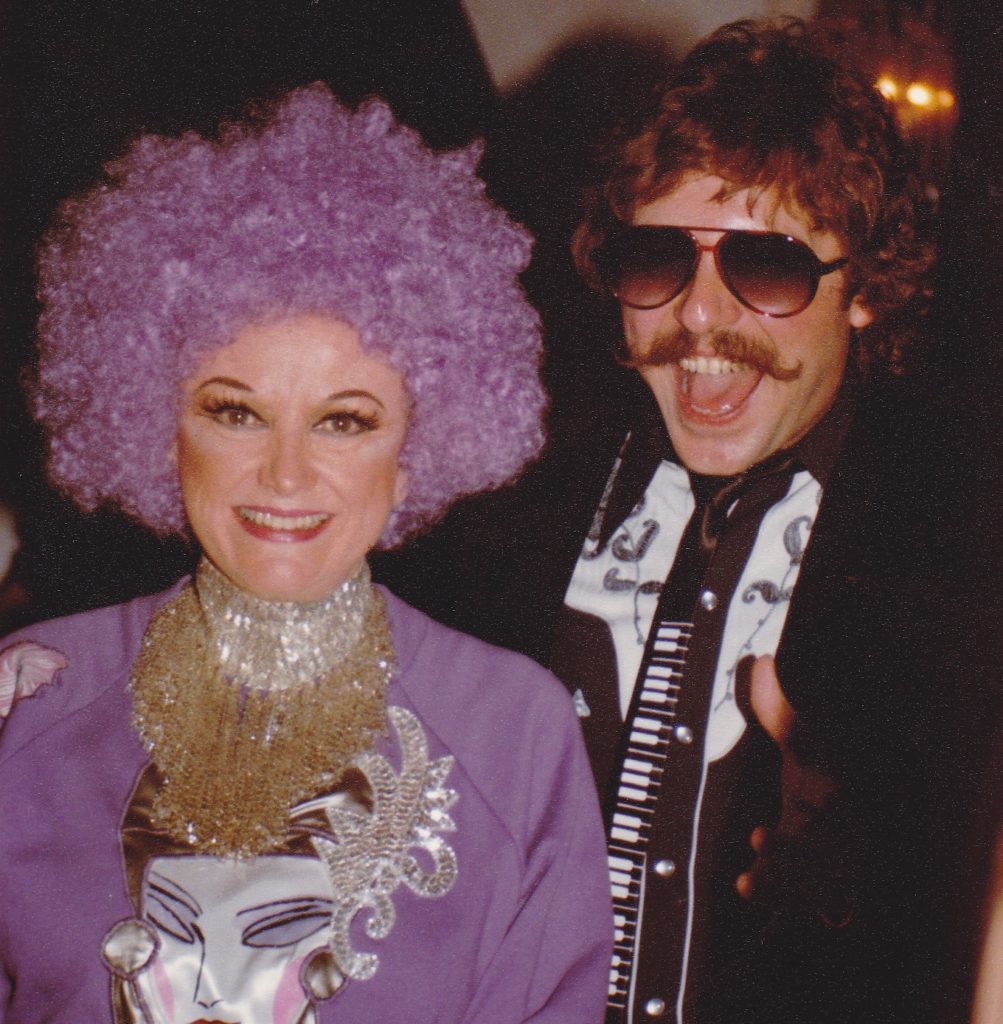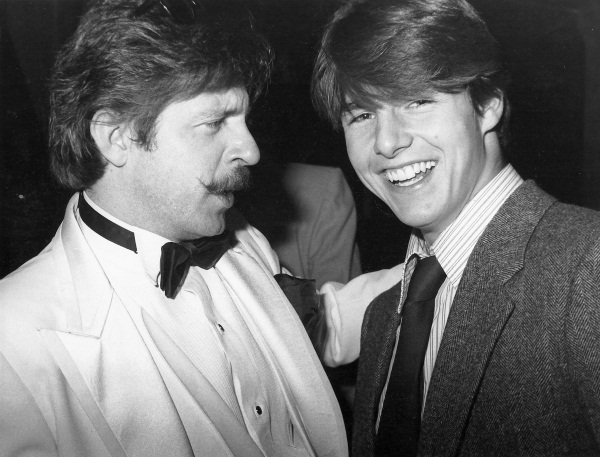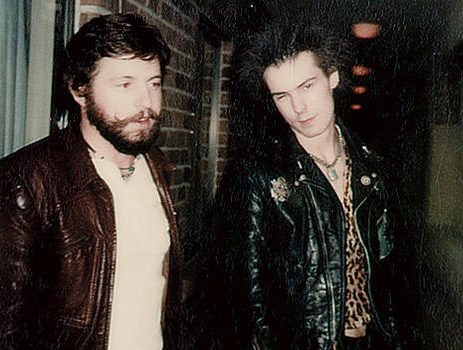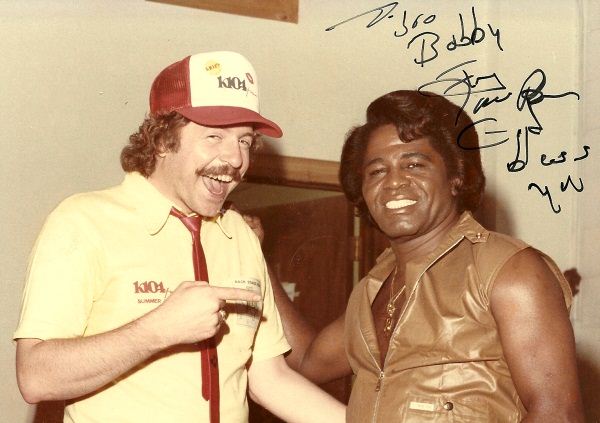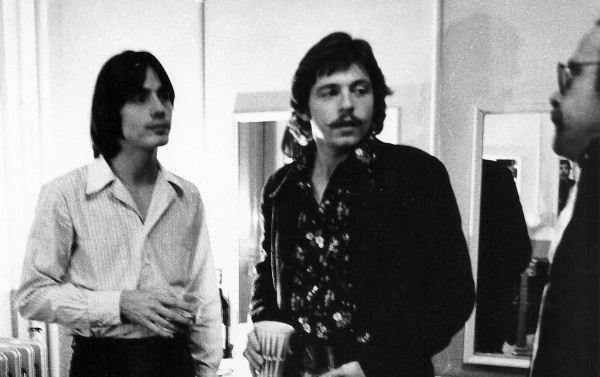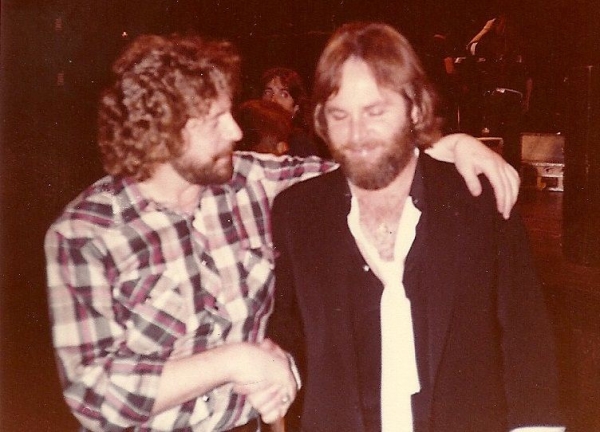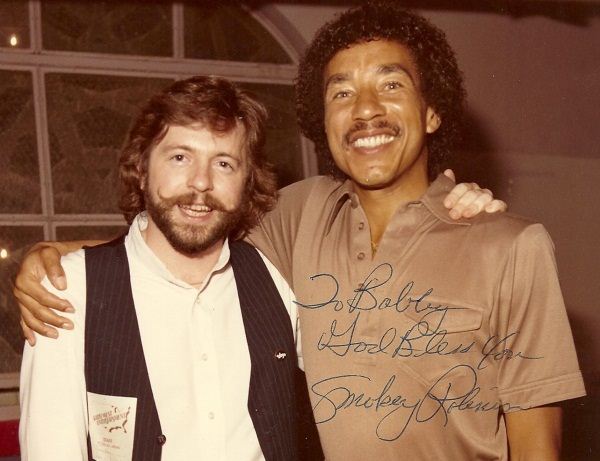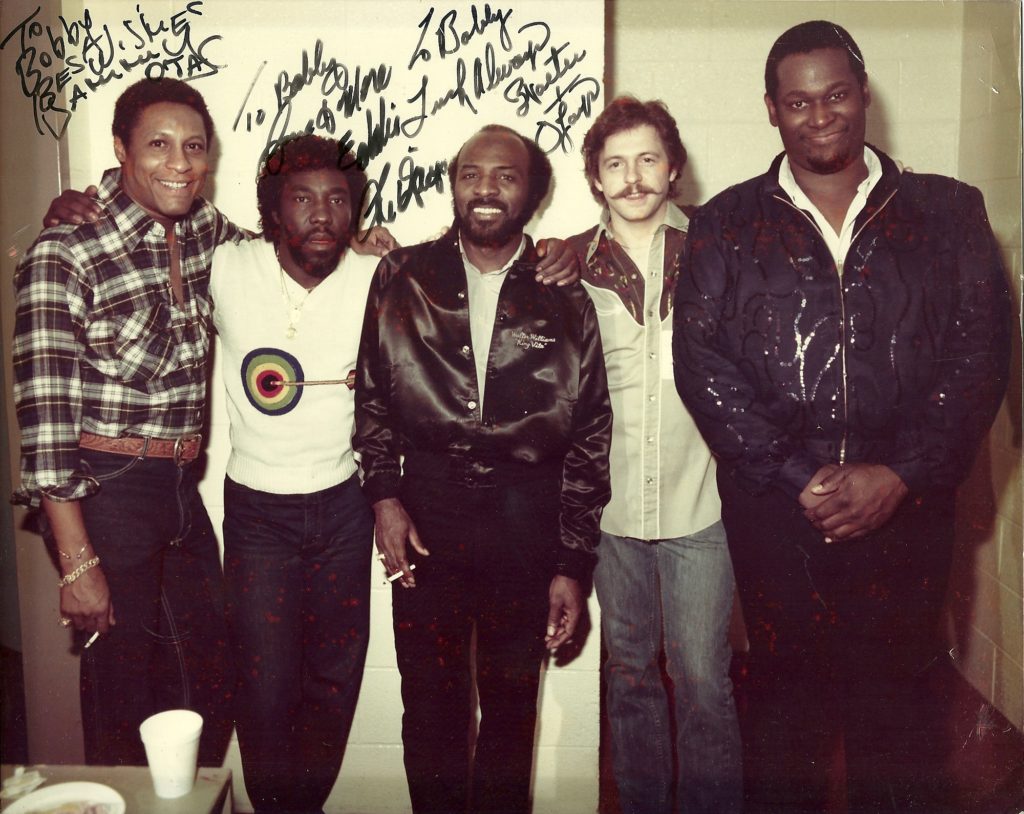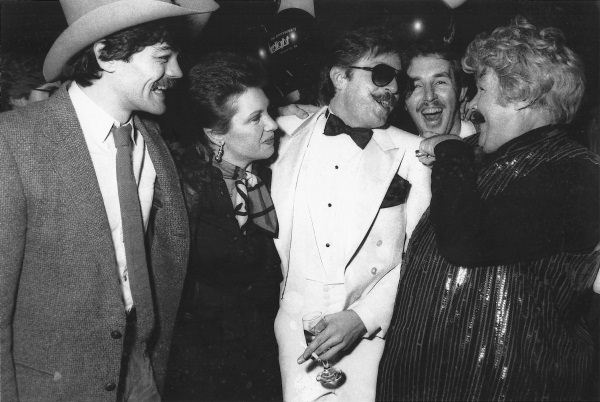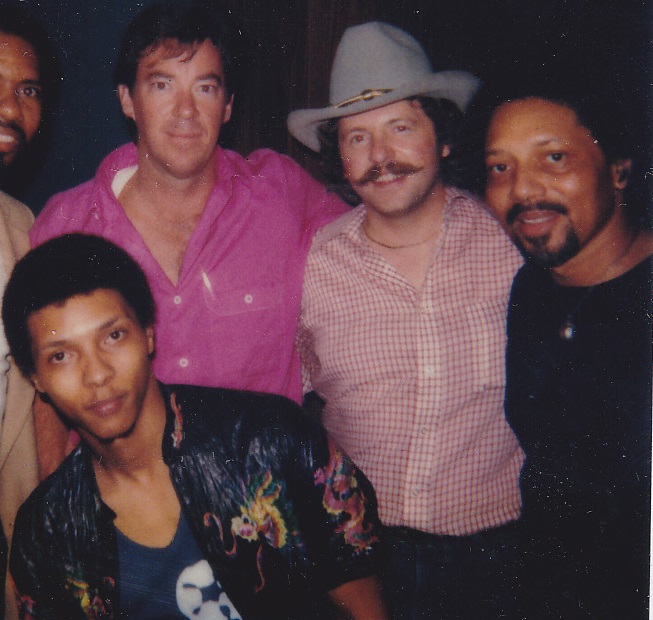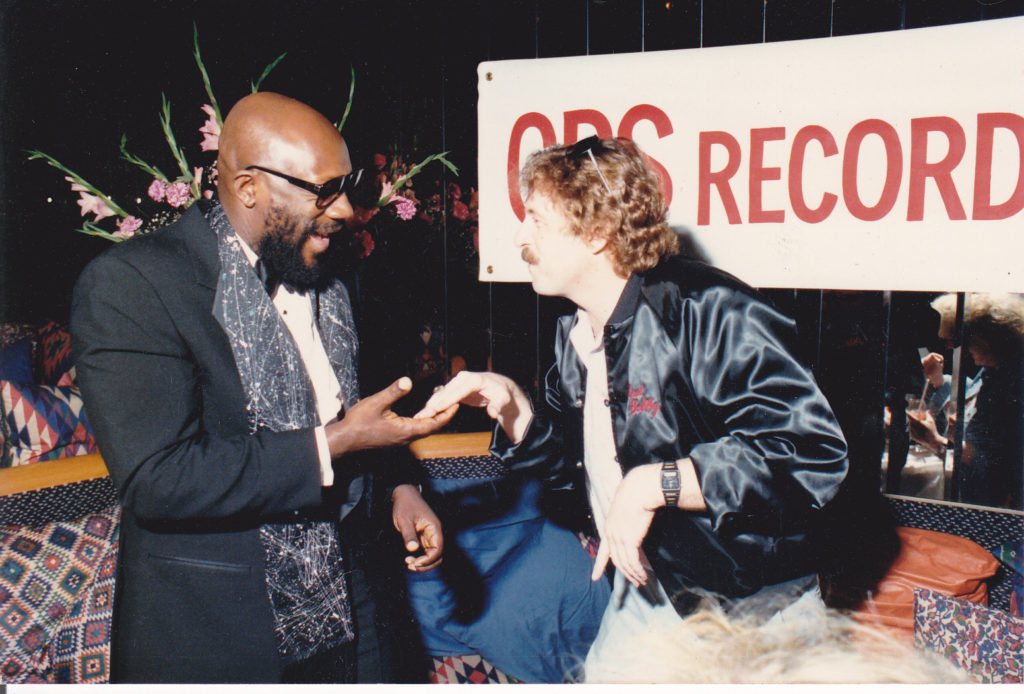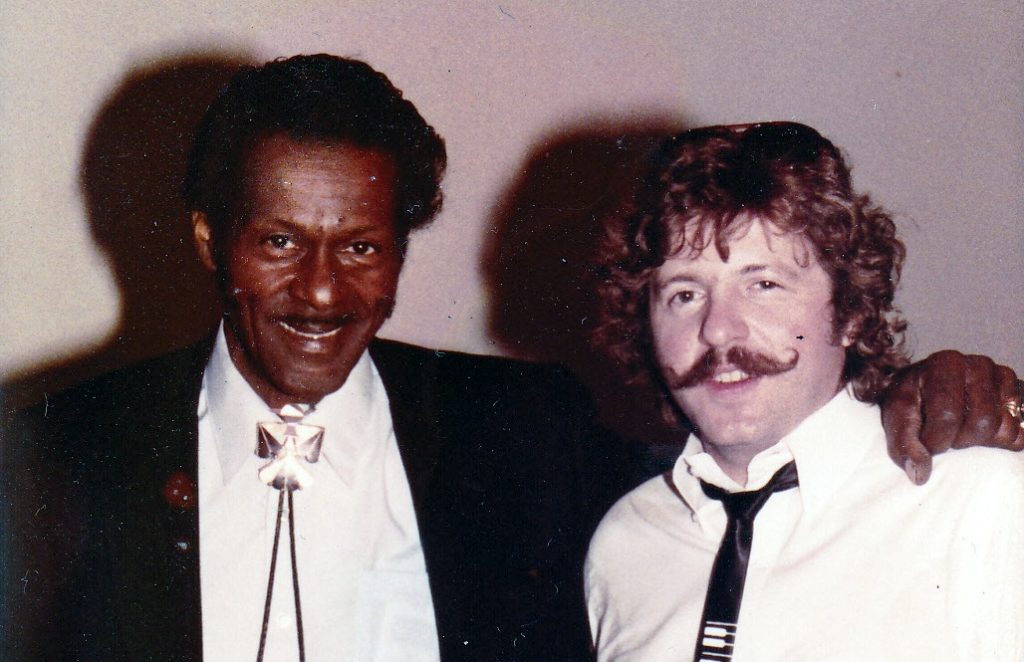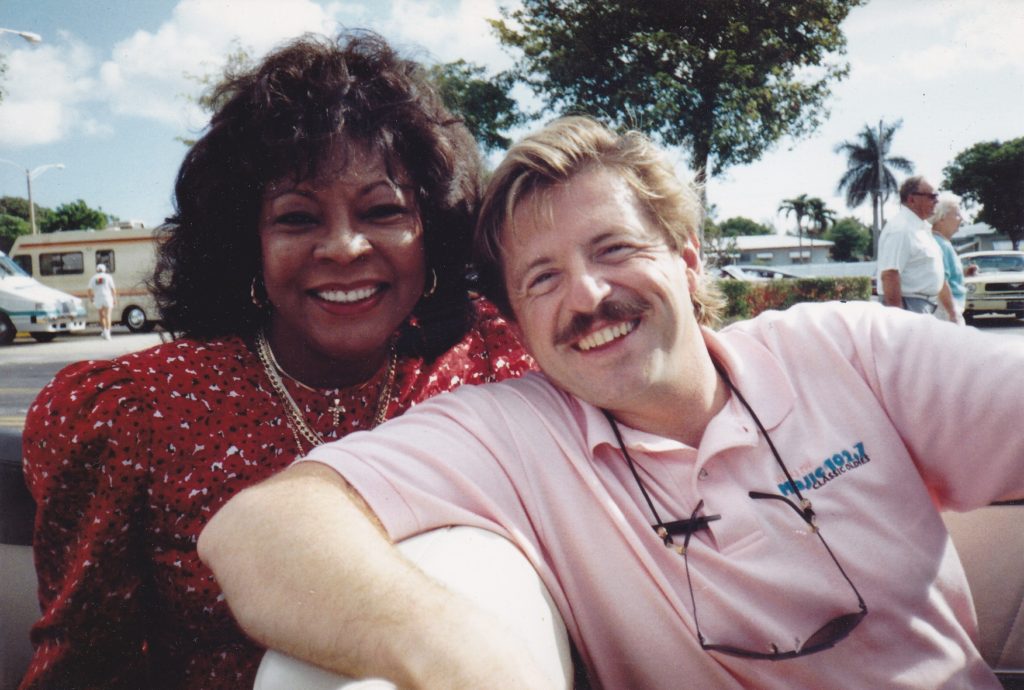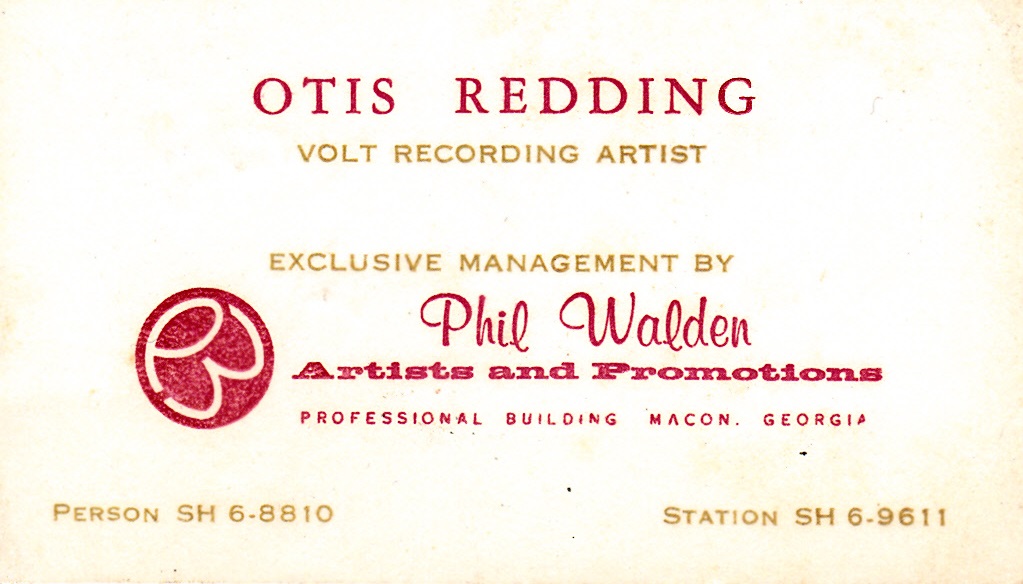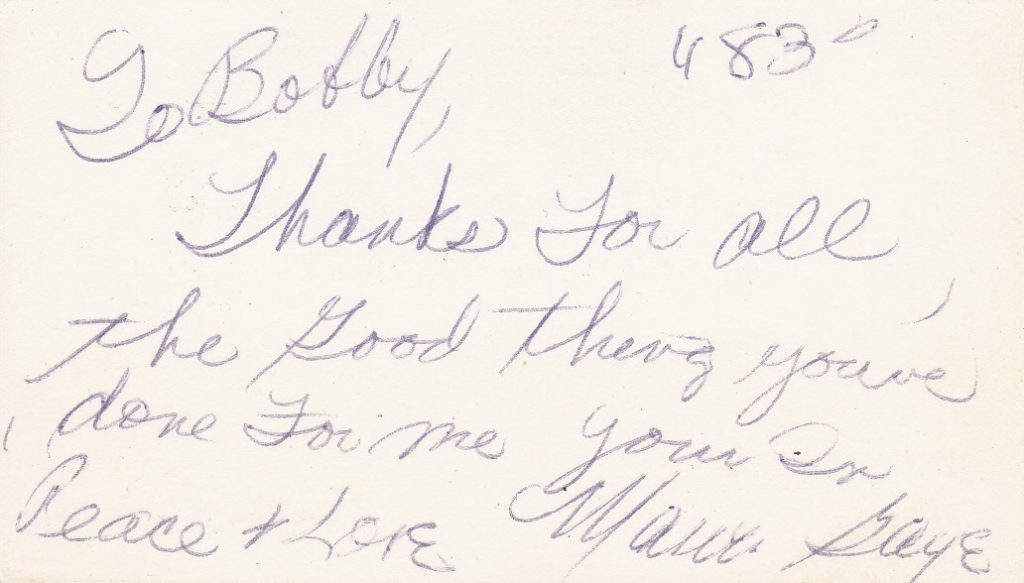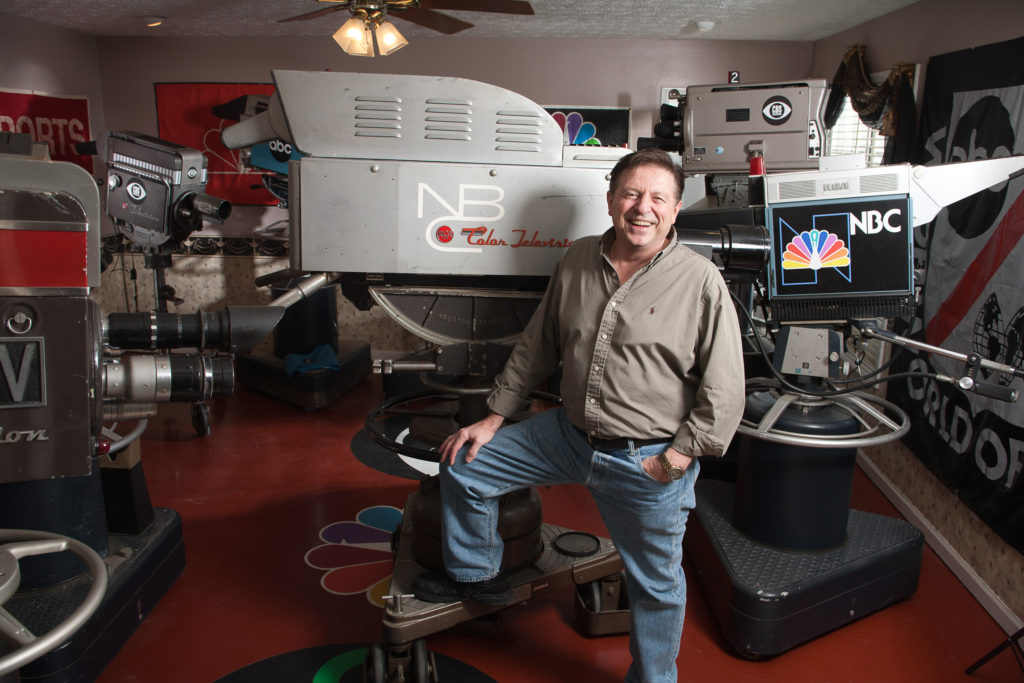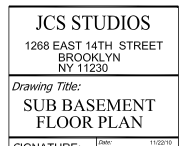November 10, 1969…”Sesame Street” Debuts On PBS
November 10, 1969…”Sesame Street” Debuts On PBS
Here is the full debut episode of the show.
Since almost almost everyone in the world knows the show, since it’s now on in 123 countries, we’ll celebrate the anniversary with a look at the early production history.
In the photos below, we see the original home of the show which was done from the old RKO 81st Street Theater at 2248 Broadway. The theater was owned by Teletape Productions, but before this, it had been the home of the first and only CBS color studio on the east coast…Studio 72 which was created in the fall of 1954.
Also shown here is an early cast and crew photo with the Marconi Mark VII color cameras. The color photo of a Mark VII shooting Grover is the one that I now have in my collection…it was Camera 2 and in the closeup, you can see that the dome tally light number is the same. There were six Mark VIIs in use on the show.
Teletape was a video production company that merged with Reeves Sound Services in 1974 and became Reeves Teletape. Before that, Reeves had been more of a sound and video post edit company.
According to our friend Dennis Degan, who worked at Reeves Teletape, R/T moved ‘Sesame Street’ production in 1983 from 81st Street to the 55th Street studio, which was formerly WNET-TV’s studio on 9th Ave at 55th Street. They made this move because R/T sold the 81st Street studio. They originally bought it from CBS in 1967.
Sesame Street was produced at 55th Street from 1983 to around 1990, first with R/T, then in 1987 with Unitel Video, as R/T went out of business. Sesame moved to Kaufman-Astoria Studios in 1990 where it has remains to this day. The RKO 81 studio was torn down in 1986. This little history lesson was brought to you by the letter B for Bobby. Enjoy and share! -Bobby Ellerbee
November 8, 1952…NBC’s First Full Color Facility Debuts
On this day in 1952, The Colonial Theater broadcast it’s first color production to the network. Fittingly, the show was NBC’s top rated Saturday night program, “Your Show Of Shows”, but it was a one time event. At least for “YSOS”, as it was NBC’s intent to rotate all of their New York based shows trough the Colonial for a color show for two reasons.
The first reason was to help teach the producers and talent how to do color shows, and the second reason was to continue to demonstrate that the RCA Dot Sequential color system really was “compatible color”…that is, received by black and white sets, just as well as regular black and white broadcasts.
I think The Colonial first came to the attention of RCA/NBC in October of 1951 when RCA exhibited a color TV receiver-projector there, which provided color pictures on a 9 x 12 foot theater screen.
At this time, the 1,300 seat theater built in 1905, was in an RKO movie theater. In 1935, RKO converted it from a vaudeville and live theater venue to a movie theater, but newer theaters nearby had taken the wind from The Colonial’s sails.
The Colonial was located at 1887 Broadway and became NBC’s 15th studio with a November 8, 1952 debut. Gone, but not forgotten! -Bobby Ellerbee
Election Day In Television Land…Special Coverage Sets
Election Day In Television Land…Special Coverage Sets
In these photos from friends prepping now in New York, here is a look at some of the sets that will be used today, starting with MSNBC’s “Morning Joe” set being built in Studio 8H for a special live audience show tomorrow. There is more on each photo, so click through. AND, in the comments section below, there is a video from Ethan Harp at The Javits Center showing the layout of the facility and stage for the Hillary Clinton event tonight. Thanks to all our friends for the pix, and for all your long hours today! Oh, and please share your electoion day pix below! -Bobby Ellerbee
November 7, 1948…”Studio One” Debuts On CBS
November 7, 1948…”Studio One” Debuts On CBS
The first episode, brought with it another first…one of TV’s first live special effects shots. In the photo, we see star, Margaret Sullivan, “driving in the rain” on the first telecast. That first presentation was titled “The Storm” and originated from Studios 41 and 42 at Grand Central. It was produced by Worthington Minor, and directed by Yul Brynner. In the other photo, we see Sullivan with co-star Dean Jagger on the set.
“Studio One” was one of the most significant U.S. anthology drama series during the 1950s. Like other anthology series of the time… “Robert Montgomery Presents”, “Goodyear Television Playhouse”, “Philco Theater”, “Kraft Television Theater”, and others, the format was organised around the weekly presentation of a one hour, live, television play. Several hours of live drama were provided by the networks per week, each play different: such risk and diversity is hard to come by today.
Offering a wide range of dramas, “Studio One” received Emmy nominations every year from 1950 to 1958, and staged many notable and memorable teleplays among its 467 episodes from 1948 till 1958.
Some created such an impact they were adapted into theatrical films. William Templeton’s 1953 adaptation of George Orwell’s novel “Nineteen Eighty-Four”, starring Eddie Albert as Winston Smith, led to the 1956 feature film version with Edmond O’Brien in the principal role.
Reginald Rose’s drama “Twelve Angry Men”, about the conflicts of jurors deciding a murder case, originated on Studio One on September 20,1954 and the 1957 motion picture remake with Henry Fonda was nominated for three Academy Awards. -Bobby Ellerbee
November 7, 1933…RCA/NBC Dedicates 30 Rockefeller Plaza
November 7, 1933…RCA/NBC Dedicates 30 Rockefeller Plaza Bldg.
On November 7, 1933 NBC held dedication ceremonies and special programs at its new 30 Rockefeller Plaza head quarters at Radio City. Thus began a five day, round the clock, parade of movers from their 711 Fifth Avenue home to their new one at Radio City.
There were 27 new state of the art studios in service, with more yet to come which would occupy two entire floors (6&7), which were left unfinished till November of 1941, when radio studios 6A and 6B were completed.
What we know as Studio 8H was referred to as the “Auditorium Studio” and 8G was called “The Radio Guild Studio”. The first broadcast was at 8PM Saturday night, Nov 11. The inaugurating sound was that of the national anthem performed by the NBC Symphony Orchestra conducted by Frank Black from Studio 8H with 1,200 special guest.
This is the story from the December 1933 issue of “Radio Engineering Magazine”. Happy Birthday 30 Rock! -Bobby Ellerbee
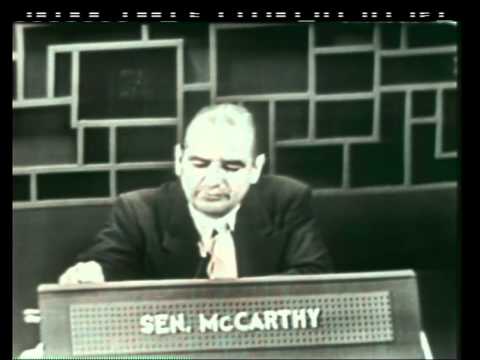

November 7, 1954…”Face The Nation” Debuts On CBS
November 7, 1954…”Face The Nation” Debuts On CBS
Wait till you see this video of the first ever presentation of “Face The Nation”! The first thing you see is a closeup of a camera’s lens turret, in a widening shot, that would be the standard open for several years. The “guest” camera is behind the set wall, shooting over the shoulders of the panel.
On that Sunday, November 7, 1954. That first ‘Face The Nation’ guest was Sen. Joe McCarthy. In the early days, the show was broadcast on Sunday afternoons at 2:30 eastern. The program’s original host was Tedd Koop, then the Washington D.C. bureau chief for CBS News and originated from the network owned WTOP in Washington.
The show as created by the late Frank Stanton, who ran the network for over 20 years. When asked why he started it, he said simply, “Because NBC had ‘Meet the Press,’ and I thought we needed a program like that.”
We miss Bob Scheiffer, but his replacement, John Dickerson is quite good and it feels like he’s been there for years. Enjoy and share! -Bobby Ellerbee
https://www.youtube.com/watch?v=FtVJFBSMXDk
In the first Face the Nation broadcast on television, Sen. Joseph McCarthy responds to questions about his infamous hearings. (CBS NEWS)
Source
November 6, 1947…’Meet The Press’ Debuts, NBC
November 6, 1947…’Meet The Press’ Debuts, NBC
This is America’s longest running television program. Almost everyone thinks of it as a Sunday morning show, but when it started, it was a Saturday night show, and hosted by a woman.
Her name was Martha Rountree and she started as a reporter at The Tampa Tribune, but she wasn’t reporting on social occasions or homemaking. As a kind of rebel from the start, her duties included writing a sports column under the name “M. J. Rountree,” with Tribune readers none the wiser as to the sex of the journalist who was, after all, writing in a field dominated by men.
A local CBS station was impressed enough by her work that they gave her a chance to write for radio, at which she excelled. From there, she headed north to New York, where she wrote ad copy, but Rountree was not comfortable playing so minor a part of an industry she felt held greater opportunities for her.
“I got the ideas, worked them out; other people got the credit,” she lamented. “I wanted to produce myself. To prove that she meant business, she and her sister Ann, opened a production firm called Radio House, which prepared transcribed programs and singing commercials.
1945 was Rountree’s banner year. She made her mark on radio in a big way, selling the idea for two different panel shows to the Mutual Radio Network, premiering them a day apart in October. One was ‘Leave It to the Girls’, the other was ‘Meet The Press’ which debuted first on October 5, 1945.
Although frequently credited as a co-creation of Rountree and Lawrence E. Spivak, publisher and editor of American Mercury magazine, authoritative sources adamantly state that it was Rountree who developed the premise on her own, with Spivak joining up as co producer and business partner in the enterprise after the show had already debuted.
Our friend Max Schindler, who directed the show for over 20 years, had this to say about the creator credit, “Whoever conceived it, it was Spivak who made it a success…he dedicated his life to it”.
Here is more from Max, on directing the show. https://interviews.televisionacademy.com/shows/meet-the-press?clip=15097#highlights
On November 6, 1947, while still on Mutual Radio, the show came to NBC Television. ‘Meet the Press’ was originally presented on Saturday night at 7:30 as a half hour show with a single guest and a panel of questioners. The first guest was James Farley, who served as Postmaster General, Democratic National Committee chairman and campaign manager to Franklin Delano Roosevelt under the first two terms of the New Deal Administration.
The first host was its creator, Martha Rountree, the program’s only full time female moderator to date. She stepped down on November 1, 1953 and until Ned Brooks could take over, her friend Deena Clark filled in.
Rountree was succeeded by Ned Brooks, who remained as moderator until his retirement on December 26, 1965. Although Spivak became the moderator on January 1, 1966, he did not really want the job. Max Schindler said, “Spivak didn’t want to moderate…he wanted Edwin Neuman, but NBC could not spare him, so he reluctantly took over”. He retired on November 9, 1975, on a special one-hour edition that featured, for the first time, a sitting president, Gerald Ford, as the guest.
The next week, Bill Monroe, previously a weekly panelist like Spivak took over as moderator and stayed until June 2, 1984. For the next seven and a half years, the program then went through a series of hosts as it struggled in the ratings against ABC’s ‘This Week with David Brinkley’. Roger Mudd and Marvin Kalb (as co-moderators) followed Monroe for a year, followed by Chris Wallace from 1987 to 1988. Garrick Utley hosted ‘Meet the Press’ from 1989 through December 1, 1991 at which time Tim Russert took over, and not long after that, the show went to a one hour format.
Russert’s untimely death gave David Gregory the seat, and now Chuck Todd is host.
Rountree died on August 23, 1999, in Washington, where she had made her name as one of the key figures in political reporting. Tim Russert, summed up her status in the medium by declaring, “She was a news pioneer who helped create a national treasure, Meet the Press.” Enjoy and share! -Bobby Ellerbee
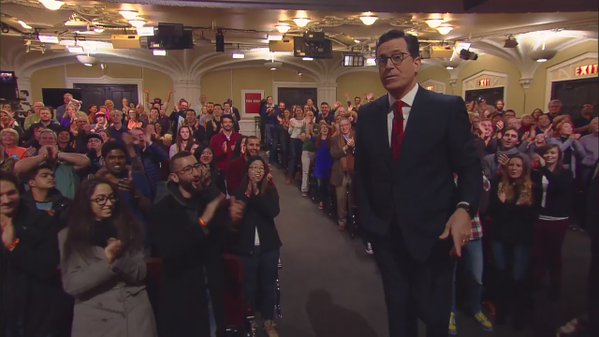
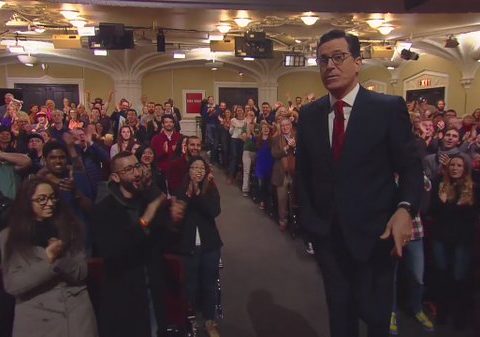
Happy Trails! Colbert’s Gentle Sendoff To John Meiklejohn……
Happy Trails! Colbert’s Gentle Sendoff To John Meiklejohn…
One of the best cameramen in the business retired last night, and Stephen gave his 11 year friend this send off. I’ve heard that as far back as 1966, they were telling JMJ stories.
This reminds me of the send off David Letterman gave to our friend, and CBS legend Dave Dorsett. Like Dave, I suspect John may be back from time to time to “fill in”. Happy Trails! -Bobby Ellerbee
https://twitter.com/colbertlateshow/status/793310612386254849


Inside The BBC’s Huge Studio 1…1974
Inside The BBC’s Huge Studio 1…1974
This is about as full a tour as you could ask for, as we are privy to every element, from the EMI 2001 cameras, to the control room and even a look at the BBC’s biggest crane in action. Thanks to Petter Olden of NRK TV in Norway for sharing this with us. -Bobby Ellerbee
https://www.youtube.com/watch?v=fJ3wYiNZJIQ
BBC
Source
ATT Telephone TV Skyway
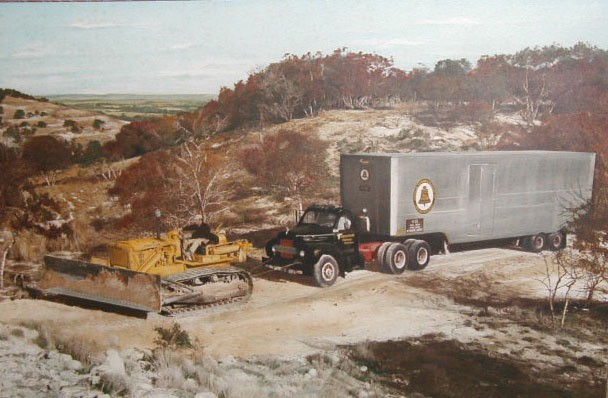
A brief, but informative look at the ATT effort to span the continent with new coaxial and microwave relay systems to enable television from coast to coast.
Total Color Camera Sales, USA, 1954-1982, RCA & All Other Brands
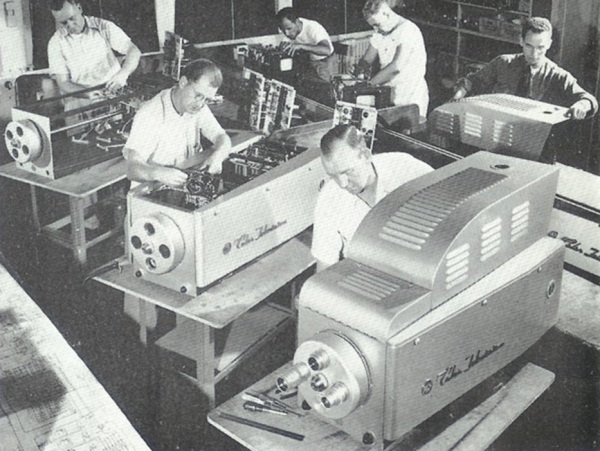
Total Color Camera Count for USA 1954-1982 from RCA, and 1964-1981 including all major brands
Thanks to our friend Lytle Hoover at Old Radio.com who has single-handedly collected volumes of information from the historic documents he has collected, we have for a few years now, had for a pretty good idea of how many RCA color cameras were sold in the US, and it’s all because of Lytle’s hard work on the charts below.
However, Lytle (below left, with Soupy Sales), has outdone himself. Under the RCA charts is a brand new creation that shows the total number of broadcast quality (High Performance) color cameras from all major brands that were sold in the US from the mid 1960s till the early 1980s.

Aside from the number of cameras sold, this chart is uniquely handy in determining when specific camera models were made, because there is rarely any dates of manufacture for these cameras available! The list includes Philips Norelco, Ikegami, Marconi, GE and more. Again, thank you, Lytle!
Here is a little background on Mr. Hoover: After directing television for 12 years (which included a long period working with Soupy Sales in Detroit), Lytle joined RCA’s Broadcast Equipment Division and became the Marketing Research Director from ’68 though ’82. Unfortunately, a lot of the valuable research Lytle compiled for RCA was lost…fortunately though, Lytle did have the foresight to save some of this information in his private files and has painstakingly reassembled these databases by hand. If you have for some reason not ever seen his photo history of RCA’s Broadcast line of studio, transmitter and videotape equipment, as well as the Virtual Library of cameras held by private collectors, including yours truly, please visit the “Old Radio” site.
RCA MARKET ESTIMATES OF CAMERAS SOLD
Below are four charts compiled by Lytle Hoover and show the estimated number of cameras sold by RCA over the 30 year period of 1954 to 1984, starting with the TK40 and ending with the TKP47. Unfortunately there are no figures available to date that show the 1947 – 1953 information or any black and camera sales figures.



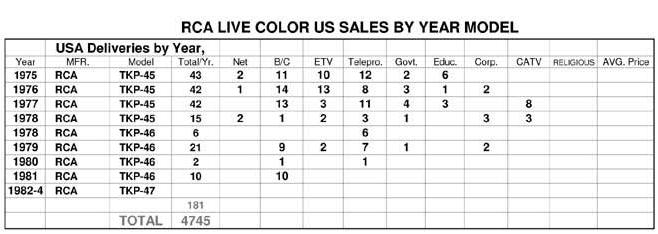
LIVE COLOR CAMERAS SOLD IN THE US BY YEAR AND MAKER
1964-1981 Includes all major brands other than RCA; H.P. = High Performance or commercial broadcast quality



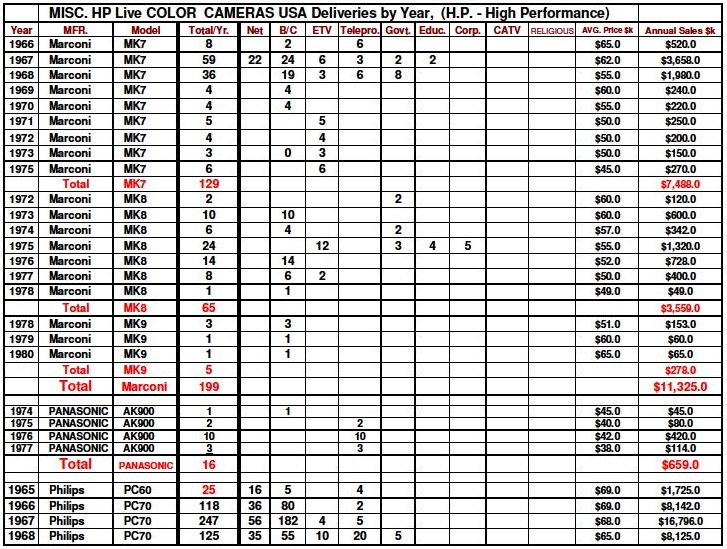
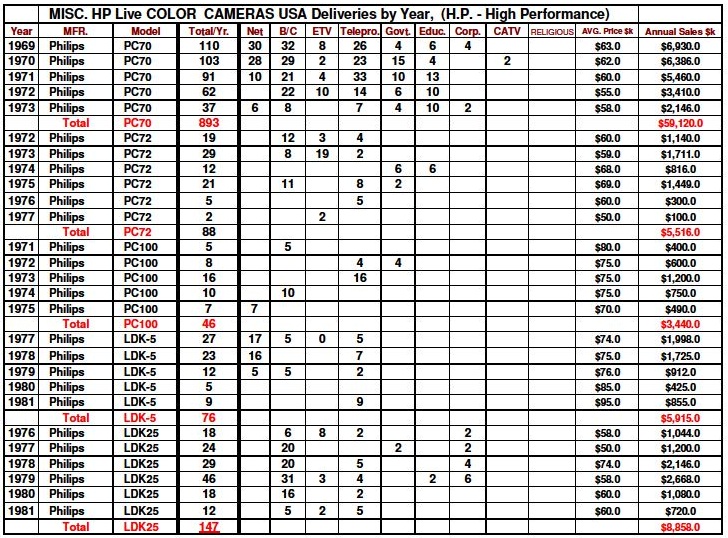

Remembering Walter Cronkite…November 4, 1916 – July 17, 2009
Today, he would have been 100 years old.
“Whatever the cost of education, the price is cheap compared with an ignorant nation”. -Walter Cronkite
This is Mr. Cronkite in Studio 42 at the CBS Grand Central studios.
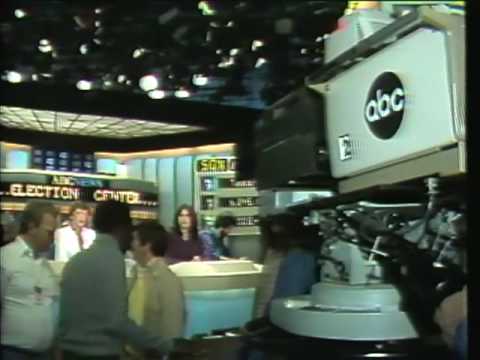
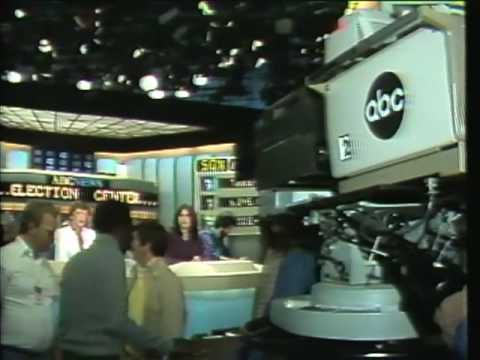
November 4, 1980…ABC Readies For Election Night, Behind The Scenes
November 4, 1980…ABC Readies For Election Night, Behind The Scenes
This WABC news clip from November 4, 1980 takes us behind the scenes at ABC’s TV 2 studio in New York as network coverage of the Carter, Reagan, Anderson presidential election nears.
As you may have read in yesterday’s Los Angeles Times article posted here, it was 40 years ago that NBC became the first to use the colorized maps in the 1976 election, and this was the first year ABC and CBS used them, but all were not on the same “color page”. It would take another 16 years for eveyone to agree on Blue for Democrats, and Red for Republicans. Voted yet? -Bobby Ellerbee
https://www.youtube.com/watch?v=smHM4Inl62I
Channel 7 Eyewitness News (WABC-TV) Political Correspondent Roger Sharp takes viewers behind the scenes of ABC’s 1980 Election Night coverage.
Source
HBO’s “Vice” News…Shout Out To Eyes Of A Generation
HBO’s “Vice” News…Shout Out To Eyes Of A Generation
On Wednesday night, this shot of this Facebook page showed up on the HBO nightly news program “Vice”, in a story on the difference between FB desktop and mobile users. This was shot over two weeks ago, since I have changed the headline photo to a color image since, but all the same, thanks to the “Vice” producers, and the man who brought the show to HBO, Bill Maher. Thanks to our friend Jeff Jaffares for sending the clip he captured on his phone. -Bobby Ellerbee
Source
About Me…Bobby Ellerbee
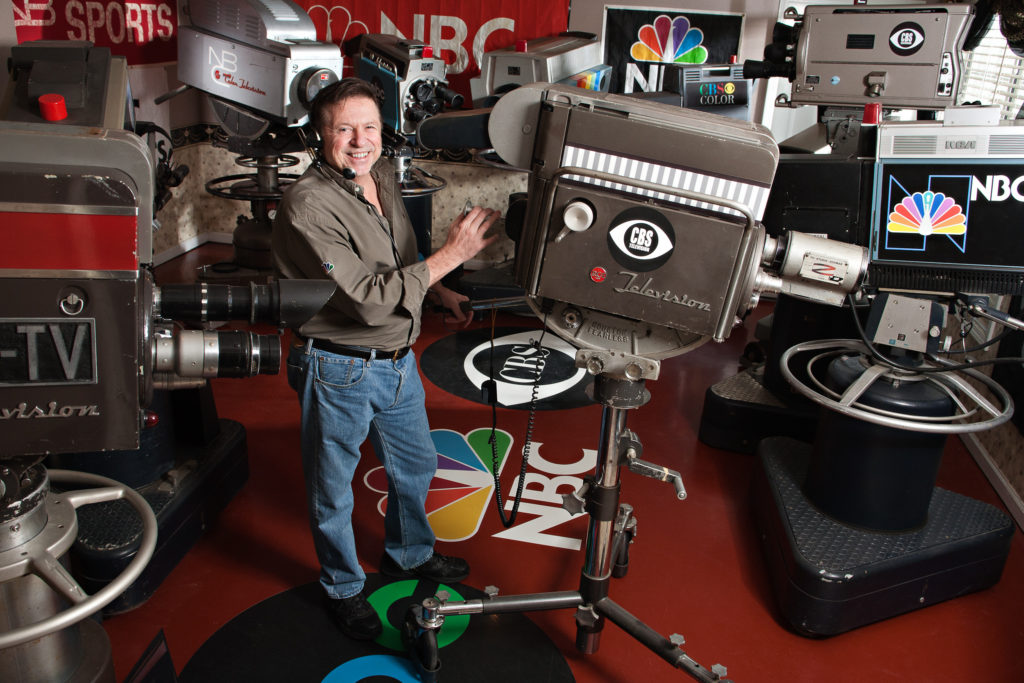
As I write this in my office here at home, there is something sitting 20 feet from me that kind of started this whole thing. It, to me, is the alpha and the omega in one. It, is a Marconi Mark IV camera (upper right, top). It was the first camera I ever wanted to own and the last camera that I wanted for my collection.
As you can read in The Ellerbee Collection, where I’ll show you pictures of the Marconi fully restored, seeing that particular camera for the first time at around age 11 sparked something in me, and I remember vividly two of them taking my picture at Georgia Public Television in Atlanta, when my sixth grade class went there to perform a dance. Even before that though, I was already interested in being a part of radio and television and that started in kindergarten.
My mother had an Electrolux vacuum cleaner that had a removable cord. One end was male, the other female and rectangular. I remember many times playing ‘announcer’ with that cord and the female end was a perfect microphone. I even had the mic cord pulling routine down to a tee and, just like the game show hosts on TV, I would walk all around the living room describing the furniture and candy bowls to my imaginary viewers. I stopped that the day I got the great idea of plugging the cord in into the wall. My mic technique was good, but it got a little too close to my spit wet lips and sparked.
Believe it or not, by the time I had finished the first grade, I had done my first national commercial and you can hear it below. The product was Windex and the venue was the ABC Radio Network.
Every weekday morning, WLS in Chicago broadcast The Don McNeil Breakfast Club nationwide from the Sherman Hotel. Fortunately, that’s the hotel my dad chose for us in 1956 when my mother and I went with him on a business trip. Mother and I got up early and went to watch, and that day, they asked the children in the audience to come up and be part of a skit with Gail Davis, who played Annie Oakley on the hit ABC western series.
There were only two kids there, me and a 4 year old girl who fortunately did not talk much. Don was talking to us and asked me a question that segued us right into a Windex live spot. As he hit the out cue line, a 12 piece band with singers played the Windex jingle. They were thoughtful enough to send me an aircheck of what I had done and I almost wore that little 45 rpm record out, listening to me on the radio. I was hooked. You can hear my edit of the Don McNeil, 1956 aircheck below in the audio files. For me, that would be the first of many thousands of air checks.
I started playing drums in the second grade (and still play), and have spent most of my life in and around music, radio and television. Fortunately, my next door neighbor owned a few radio stations, and at age 16, I began my career as a broadcaster. I was a disc jockey on weekends till I finished high school. I was a full time DJ at WRFC and WDOL in Athens, and WZGC in Atlanta while attending the University of Georgia’s, Grady School of Journalism where I majored in Radio, TV and Film. Below, at age 18, I am interviewing two big stars of 1968…Johnny Rivers and Gary Puckett. Under that I’m on the air at age 20 at WDOL in Athens.
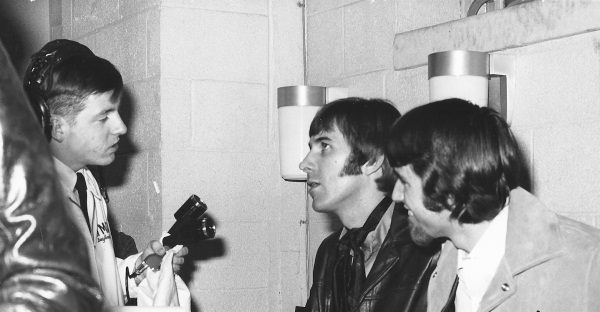
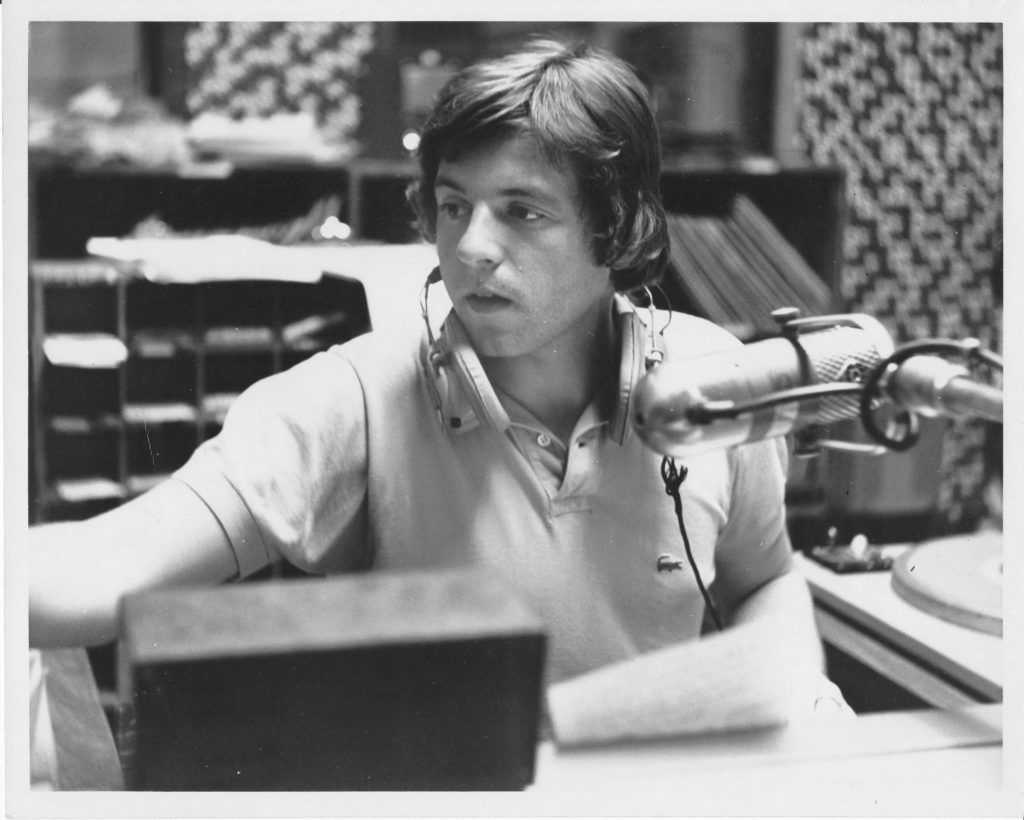
I wanted to be a television director, but, as it turns out, I was pretty damn good on the air and my radio abilities kept me in demand for 22 years. I was on the air six days a week, usually in afternoon drive, and had the privilege of working with some of the best radio people in America.
I worked in Top 10 markets at stations like 96 Rock/WKLS and V103/WVEE in Atlanta. K104/KKDA Dallas-Ft. Worth, The Big 610/KFRC San Francisco and I put the first HOT format station on the air as the afternoon personality at HOT 105/Miami-Ft. Lauderdale-Palm Beach. I finally got into television too as the main voice for NBC 6/WTVJ Miami. You can hear the KFRC, HOT 105 and NBC 6 airchecks below in the audio player.
I spent nearly 20 years in South Florida before moving back to the Athens area, and until 2015, I was still heard there daily on both radio and TV. At age 38, I left the daily, on air part of radio and became the Creative Director for Miami’s top radio group, WLYF/WMXJ/WAXY. I was writing and creating award winning advertising for local, regional and national clients there. I also started doing a lot of national voice work then too, and for 5 years, I was the world wide voice of Johnny Walker Black Label Scotch. The checks from Johnny Walker were from the Royal Bank Of Scotland and were hand written by a professional calligrapher. They were almost too beautiful to deposit…almost.
I’ve had my own creative broadcast services company since 1989 when I began working with South Florida’s top luxury car dealership, Warren Henry Automobiles. As of 2015, when our 25 year relationship ended, I had done over 1,200 consecutive monthly campaigns on radio and television for this one client alone, I’ve also worked with other luxury car clients around the country and even exotic brands like Rolls Royce, Bentley, Ferrari and Lamborghini. I’ve created broadcast advertising for some of the country’s top home furnishings chains, high end lighting dealers and manufacturers and exclusive residences and realtors, winning two national awards for my work on spots for Jupiter Medical Center and Thunderball Yachts…the 007 yacht makers.
I also wrote, voiced and produced all of Dick Clark’s commercials for his American Bandstand Cafe chain. He was great to work with and, yes, I always left donut holes for Dick’s voice, which he would gladly record and send me the tape.
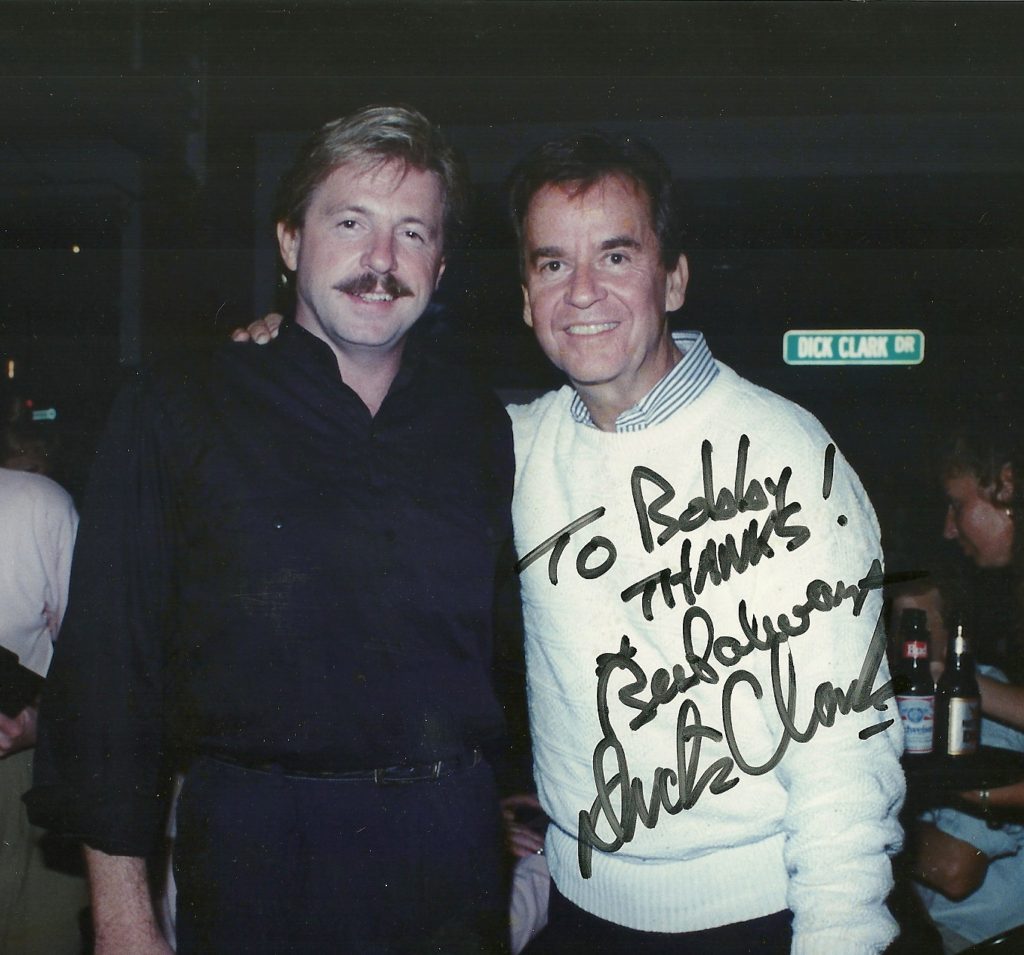
I have created more spots for Infiniti and Jaguar than anyone, anywhere, and I’ve attached a demo of some of my radio spots, as well as me on the air in San Francisco and Miami in the audio player.
Something else I’ve always wanted to be is a cartoon character, and now I am!
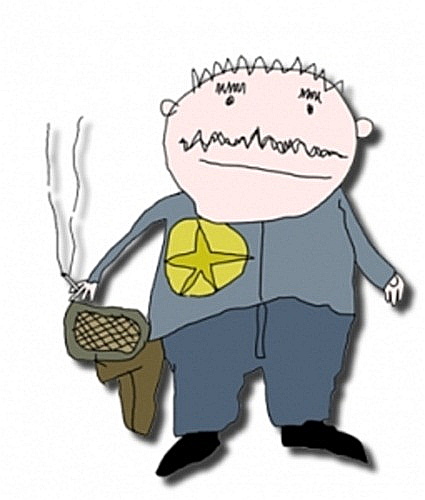
Since 2006, I’ve been the voice of the Sheriff on ‘Squidbillies’. We’re on the Cartoon Network’s, Adult Swim…a night time programming block of cartoons for adults. That means we get to use cuss words. Thankfully, we are a huge hit with the college set and beyond. Last year, even though we are on cable, we actually won our time slot nationwide for men 18 to 34 including all broadcast channels! Below are a few quick excerpts that I think you’ll like. My character, Sheriff is the only human on the show and a nice guy at heart, but does carry a very big gun though and is not to be messed with.
The Playlist is in the top, upper left corner. There are 4 short cartoon clips, and clip 5 is a behind the scenes video, that I think you’ll enjoy.
| I was auditioned and hired after the first six episodes, when veteran actor Charles Napier was released from his contract
Charles has been in movies that range from “The Blues Brothers” to “Silence Of The Lambs” and has a very distinct voice. After I Goggled him, I knew immediately who he was and was quite surprised that we sounded so much alike. We are working on Season 11 now! I got pretty restless in the summer of ’73 and I decided to leave radio, and UGA to work in the music business for a record company. That would be Capricorn Records in Macon, and that would be at their peak when they had huge acts and albums. Although I went back to school a six months later, and back into radio, that experience opened a door that has really never closed and gave me a once-in-a-lifetime opportunity to meet and tour with some of biggest of the big names in music. By the way, I finally graduated from UGA in 2016, by going back and taking five elective courses in my minor. Here is the NPR story I did with Linda Wertheimer about my return to college. http://www.npr.org/2016/05/15/478114640/after-40-year-detour-squidbillies-voiceover-actor-graduates-college I’ll make a long and fascinating story short and sweet. While working for Capricorn, Gregg Allman’s album ‘Laid Back’ and the Allman Brothers ‘Brothers and Sisters’ came out. I took Gregg to Athens to jam with Elton John at the UGA Coliseum. Elton introduced me to Robert Nix of the Atlanta Rhythm Section. Robert and I became best friends, and still are. Robert’s other best friend was Ronnie Van Zant. Yep…Skynyrd. When Skynyrd needed a new drummer, I recommended Atriums Pyle who I had heard about from Doug Grey of Marshall Tucker. Ronnie auditioned him and, bingo…new drummer. I used to live with Skynyrd bass player Leon ‘Uncle Only’ Wilkerson. God Bless you Robert! We’ve had some mighty fine ’emotional holidays’ together. To Gregg Allman, I’d like to say thank you for ‘naming me’ Bobby. Before I met you, I had always been called Bob and hated that name. |
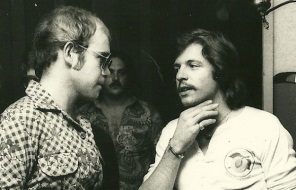
Above, that night in Athens with Elton John, and below, Gregg and I at the 1974 Capricorn Picnic in Macon.
|
|
Through Robert, Gregg and Ronnie, I’ve met everyone from The Rolling Stones to Count Basie. Although, being in radio for so long, I met a lot of music greats there too and have interviewed a few hundred of them like Dizzy Gillespie, Chaka Khan, Dionne Warwick, Marvin Gaye, Willie Nelson, Jackson Brown, Isaac Hayes (who for years called me Bobby Lee…we miss you) Stevie Wonder, Frankie Vallie, James Brown, Patty LaBelle, Julio Iglesias, Frank Zappa, Sly Stone, Dick Clark, George Benson, Smokey Robinson and so many more, I can’t remember them all, but I do remember Luther Vandross. He and I were dear friends and I miss him. It was also fun to interview comedians and actors too like Tom Cruise, Red Foxx, Phyllis Diller, Fay Dunaway, Wayland Flowers and Madam, Chris Atkins, John Davidson and Harrison Ford. Below top, me with Michael Jackson in Atlanta, Under that, Phyllis Diller and I on my 33rd birthday in Dallas. Third down, me a very young, 19 year old Tom Cruise on a long fun night at Limelight. Forth down, Julio Iglesias in my recording studio in Miami.
One of the things I used to enjoy the most was introducing people at their concerts, which is one of the perks of being a top rated radio personality. I knew Ike and Tina long before they spit, but was quite honored to introduce Tina Turner in her very first solo concert on the Private Dancer tour in Dallas Texas. Some of the other headliners I’ve had the pleasure of introducing on stage were Michael Jackson, ZZ Top, Junior Walker and The Allstars, BB King, Led Zeppelin, Eddie Floyd, James Taylor, Roberta Flack, The Beach Boys, Martha Reeves and The Vandellas, Linda Hopkins, Ertha Kitt, Billy Joel, Etta James, J. Giles Band, Sly and The Family Stone, Billy Preston, Prince, Rick James, Carol King, The Temptations, Tommy James and the Shondells, The Four Seasons, The Four Tops and a lot more, but one that I must include, was introducing the Sex Pistols at their first ever US appearance. We spent a long and interesting night together. Actually, most of those nights were long and interesting. One night, I was invited by Earth Wind and Fire’s manager, Steven Fargnoli to see a new act he had. It was the first time they had played in public and there was a table for me that I shared with Tim Curry from Rocky Horror. The act was Prince. Tim and I were blown away. I could tell you a lot more great stories, and I may eventually write a book about all the sex, drugs and rock and roll…the working title I have in mind is, “If Balls Could Talk”. Like that? Below, top, it’s me with Sid Vicious at their US debut in January of 78. Next picture down, me and the Godfather of Soul, James Brown who I first met at age 18. He was one of the nicest guys you ever wanted to meet…really a very kindhearted man. Next, Jackson Brown and me around 1977.
Below, one of the greatest voices ever, The Beach Boys’ Carl Wilson and me. Carl sings the lead on ‘God Only Knows’, and got it right on the first take…a classic song, and we miss Carl and Dennis Wilson. Below that, The great Smokey Robinson, then (L) James Ingram and (R) Peabo Bryson., and then me with my buddy Luther Vandros and The O’Jays.
Below, disco down with Randy from the Village People, Alicia Bridges who sang ‘I Love The Nightlife’ (and we did), me and funnyman Rip Taylor. Robert Nix and I used to call Alicia Bridges ‘Loose-ya Britches’. Below that, the night I introduced Boz Skaggs to The Neville Brothers, then The Pointer Sisters in San Francisco, me and Willie Nelson, and my friend Issac Hayes, who called me Bobby Lee. Then, rollin’ over with Chuck Berry and almost ready to dance in the street with Martha Reeves.
Finally, a treasured memento from Marvin Gaye. I met Marvin with Otis Redding in early 1967, at which time Otis gave me and Marvin his card. Later that year, Otis was gone, but I saw Marvin many times after that and we became friends. My favorite song of all time is his “Ain’t No Mountain High Enough”, with Tammy Terrell. The first time I ever heard “What’s Going On”, Otis Redding’s brother Rogers and his wife, Zelma were in my car in Macon…we were all so excited, we pulled off the road to listen. I introduced Marvin at Reunion Arena in Dallas in April of ’83, and told him the story about Rogers and Zelma. He loved it and before I could say another word, he reached into his bag and took out Otis’s card, that he had carried with him since we all met. He flipped it over and wrote this note to me on the back of it. That gesture was so stunning to me, I was was without words…but…shortly, so was he! He did not know I had brought the card Otis gave me that night. I was going to show it to him as a reminder of where we met, but as usual, Marvin had outdone himself in his graciousness. When I pulled out my Otis card, he laughed and hugged me. I gave it to him to replace the one he had given me. We both almost cried.
Have I ‘dropped’ a lot of names here? Well, yes and no. This was my life though. These are the things I did and the people I did them with. Most of us in radio and television could reel off a lot of impressive names we’ve worked with over the years, but what I hope those names above do is remind you of the great music they made, and the times it reminds you of. When I think of the TK41 period for instance, I think of Andy Williams and “Moon River”. Perry Como and “Catch A Falling Star” and “Impossible”. I think of the great Broadway songs from Learner and Lowe, Rogers and Hammerstein, Gershwin, Berlin and Johnny Mercer and plays like The King and I, Oklahoma, The Music Man and movies like Breakfast at Tiffany’s, Butterfield Eight and The Longest Day. I think that’s one of the reasons I love these cameras so much. It’s not just the cameras…it’s the periods. I think the 1950s, ’60s and ’70s were some of the best times we have ever seen in this country. Innovation was everywhere, everything and everyone was alive and thriving, and deep down, I think most people were pretty happy. People were different then. The cameras take me back there. I had a great childhood and the cameras remind me of it, and here is the big because…because I loved television and the shows it brought me, as much as I loved the radio and the music it brought me! I loved watching Red Skelton and Jackie Gleason with my mother and dad, and later, my little brother. I loved Howdy Doody and cried when Clarabelle finally spoke on the last show and said “Goodbye kids”. I loved the Popeye Club, The Three Stooges, Pete Smith Presents, Yogi Bear, Quickdraw McGraw, Huckleberry Hound, Sky King, Roy Rogers, Leave It To Beaver, Ozzy and Harriet, Art Linkletter’s House Party, Queen For A Day, I’ve Got A Secret and just so much more. I loved Bill Cullen, Gary Moore, Bud Collyer, Walter Cronkite, Chet and David, Bullwinkle. Mitch Miller was a little to square for me, but I loved The Dean Martin Show, Bob Hope, Bonanza on Saturday night and Walt Disney on Sunday nights, Gunsmoke, Have Gun Will Travel, Maverick (I can still sing the theme song), Get Smart, Man From Uncle, Car 54, Arthur Godfrey and of course, Ed Sullivan. When I think of the Norelco cameras, I think of Carol Burnett, Smothers Brothers, Glenn Campbell and Television City. Good memories. As I said on the Welcome page, it was only recently that I realized I loved the pictures of the cameras working on these shows almost as much as I love the cameras. The cameras are the special vortex…the special time and place machines that bring the world to me and all of us. Without them, there is no TV. There are tens of millions of television receiver sets, but never more than a few hundred cameras across the nation to originate the images and the stars could not be stars without them. In the black and white days, there were never more than 50 cameras in New York or Los Angeles, and in the early color days, there were even fewer…maybe three dozen on each coast. In closing, all I can say is that I’ve tried very hard to put together the very best pictures I can find. I’ve had a lot of help from a lot of people and thank you all for sharing and visiting Eyes Of A Generation…to me, this is the world’s virtual museum of Television, and it’s cameras, from the Golden age and beyond. My grateful thanks to you for visiting. God Bless you. Bobby Ellerbee
|
Ellerbee Classic Camera Census
This is the world’s first and only count of the remaining studio size television cameras from the Golden Age and beyond.
Over 60 years of history is represented in this survey. The sad news is, there are very few that have made it. Included in the census are the RCA, Norelco, Marconi, GE and Dumont studio size cameras, and for the first time, I’m adding the Ikegami line to the list.
Also for the first time, I am attempting to count cameras on a worldwide basis. Most cameras are in the US, but thanks to Dicky Howett in England, we have a more comprehensive count on cameras abroad. I have now included the RCA and Marconi cameras at Dicky’s Golden Age TV Recreations prop house and some others in UK museums, at the BBC, and in Australia and New Zealand.
No ENG, or shoulder-mounted cameras are included, nor are Sony or Ikegami cameras. Fortunately, two compete TK41 camera chains have been found since our last update, as have a few TK41 camera heads. A few more GE and Marconi cameras have surfaced and so have a few early RCA black and white camera heads. A large number of cameras from History For Hire have been added too. Since our last update, a few collections have been sold and a few added to. I am also happy to report that a very rare 1939 RCA Iconoscope studio camera has surfaced to join Steve McVoy’s field version of the 1939 RCA Iconoscope camera. That makes a grand total of 324 RCA cameras left.
I’m sure there are others out there, but my bet is, less than 50 more than the 459 total cameras listed here. I have tried to be as inclusive as possible and have been in touch with not only private collectors like myself, but all of the major museums and archival sources that I know of including the sources below. If there are collections or sources that you would like me to know about for inclusion in the list, please feel free to contact me.
THANK YOU ALL for Participating! Bobby Ellerbee
SPECIAL NOTE: To see some great charts and tables that show when certain cameras were manufactured, please see in this same section (Archives), TOTAL COLOR CAMERA COUNT by Lytle Hoover.
ABBREVIATIONS:
SSM = Smithsonian Institution National Museum of American History; information provided by Elliot Sivowitch (curator and “great grandfather” of all Television collectors)
MBT = Museum of Broadcast Technology in Woonsocket, R.I. (curators, Paul Beck and Tom Sprague)
MBC = Museum of Broadcast Communications in Chicago (curator, Bruce DuMont)
NEW = The Newseum in Washington, DC (curator, Carrie Christofferson)
VM** = Virtual Museum Page on Old Radio.com (curator, Lytle Hoover)
**For clarity, to avoid double counts, the cameras on the VM site have been included individually in the counts below
UCLA* = University of California at Los Angeles, Television Archives (curator, Dan Einstein)
*see other cameras at end
PIC = Private Collection, owner wishes to remain anonymous
ETF = Early Television Foundation, Hilliard Ohio (curator, Steve McVoy)
UN = University of Nebraska College of Jrl. and Mass Comm. Lincoln, Nebraska
HFH = History For Hire, the top prop shop for TV equipment in Los Angeles
MRT = Museum of Radio and Technology, Huntington, W. Virginia
SM = Schenectady Museum, a major repository of GE archives
HFM = Henry Ford Museum, Dearborn, Michigan
MBC = Museum Of Broadcast Communications, Chicago, Illinois
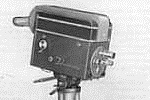

RCA TK10 (left) – TK30 (right) Series:
Bobby Ellerbee: 1 TK30, The Pat Weaver NBC Camera, presented to first President of NBC TV in appreciation for his achievements in programming. See the Ellerbee Collection for more.
Bobby Ellerbee: 1 TK10, one of the original 8 bought and used at WGN in 1948
Billy Graham Museum: 1 TK30
Chuck Pharis: 1 TK10, 7 TK30
Allan Weiner*: 1 TK10, 4 TK30
Tom Long: 1 TK30
UCLA: 1 TK10, 1 TK30
SSM: 1 TK30
PIC: 1 TK10, 1 TK30
Dicky Howett: 1 TK10, 1 TK30 (England)
Steve Selinger: 1 TK30A
ETF: 3 TK30A (on loan with 1948 RCA TJ 48 remote truck from Ohio State Historical Society)
UN: 1 TK30A (serial # 24, originally owned by WOW-TV Omaha)
Julian Burke: 1 TK30
Bill Kuhar: 1 TK30 used at CBS Studio 55 in NYC
Edwardo Suarez: 1 TK10
HFH: 3 TK30, 1 TK10
Ed Sharpe: 1 TK30
VM – KFOR: 1 TK30
Total TK10 and TK30 = 38 (Running Total = 38)

RCA TK11- 31 Series:
Bobby Ellerbee: 1 TK11-A-1
VM – Kennedy Library: 2 TK11 from WBBM Chicago (original Kennedy-Nixon Debate cameras) with thanks to the SSM
VM – Lloyd Scott: 1 TK11
VM – WHIZ-TV: 1 TK11
VM – Sarnoff Library (Courtesy of Dave Abramson): 1 TK31
MBT: 4 TK11/31
Chuck Pharis: 8 TK11/31
Jay Ballard: 1 TK11
Allan Weiner *: 2 TK11, 4 TK31
UCLA: 1 TK11 (from KTLA, donated by Steve Dichter)
Michael Aisner: 1 TK11 (from the Chuck Pharis Collection)
UCLA: 1 TK11, 1 TK31
SSM: 1 TK 11
Julian Burke: 3 TK11s
MBC: 1 TK31 (the remaining Kennedy-Nixon debate camera that was originally gifted Northwestern University)
David Johnson Collection: 1 TK31 (complete chain)
NBC: 1 TK31 (Rockefeller Plaza display)
Ronald Purtle: 2 TK11A
ETF: 1 TK31
Jan Lowery: 1 TK 11A (purchased from Chuck Pharis)
UN: 1 TK 11/31 (serial # 1420, originally owned by KUON-TV at UN)
Jim Bragg: 1 TK11
Edwardo Suarez: 1 TK11
Bill Howard, KOCO: 1 TK 11
HFH: 3 TK11
Chuck Conrad: 1 TK11A (Serial # 1475, from KIIV Sherman TX)
Dicky Howett: 1 TK11 (England)
Ed Sharpe: 1 TK11
VM – WHIZ lobby: 1 TK11
VM – Bill Howard: 1 TK11
VM – WEWS lobby: 1 TK11
VM – Oklahoma Historical Society: 1 TK11 (from KETA)
Total TK 11/31 = 54 (Running Total = 92)
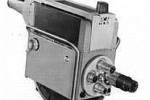
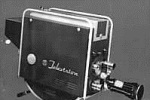
RCA TK14 (left) and (right) TK15:
Chuck Pharis: 2 TK15, 2 TK14
PIC: 1 TK15
Alan Weiner: 2 TK15
MBT: 1 TK14, 1 TK15
Ed Sharpe: 2 TK14
Total TK 14/15 = 12 (Running Total = 103)

RCA TK40 – 41 Series:
Bobby Ellerbee: 1 TK41C (from KTLA: former ‘4th sister’ to the Red Skelton TK41A cameras now at UCLA)
Ed Reitan: 1 TK40A (one of the first CBS Television City color cameras, Los Angeles)
Kris Trexler: 1 TK41C (from KSTP)
MBC: 1 TK41C (from WGN)
UCLA: 3 TK41Bs (the Red Skelton, Red-E-O Video cameras were sold to KTLA; now archived at UCLA)
David Woods/WCOV: 1 TK41C
Chuck Pharis: 1 TK40 (“1952 earliest known RCA color camera. This is a 1 of only 2 prototypes built and used for testing by NBC on sports coverage. It bridges the gap from ‘coffin cameras’ to production model. RCA/NBC later updated the viewfinder and some internals on this camera as it entered regular service at NBC Burbank when the TK40 production models arrived.)
Chuck Pharis: 5 TK41 (one with complete chain, twin of Rick Wold’s new TK41)
MBT: Jay Ballard’s 1 TK41B and 1 TK41C on permanent display
Allan Weiner *: 1 TK40, 1 TK41
Bob Ennis: 1 TK41C (from the Chuck Pharis Collection)
Steve McVoy: TK41C (no viewfinder…yet) Early Television Museum in Hilliard, Ohio
SSM: 1 TK41 (from WALB-TV, Albany, Ga.)
PIC: 1 TK41C
Axeman Army-Navy Store: 1 TK41 (on display at their Minneapolis store)
Chalina Johnson: 1 TK41C (bought from Chuck Pharis)
Leonardo Ferraz: 1 TK41C (complete chain)
Oklahoma State Museum: 1 TK40A twin of the MBT TK40A from WKY-TV, one of a pair (see MBT below)
MBT: 1 TK40A, one of a pair of the first 2 color cameras delivered to a local station WKY-TV; twin at OK State Museum
Julian Burke: 2 TK41C
Rick Wold: 1 TK41C (complete chain, twin of new Chuck Pharis TK41)
Jim Bragg: 1 TK41C
HFH: 3 TK41s from CBS
Ed Sharpe: 1 TK41C
PIC: 1 TK41C (a former director in LA has one but wishes to keep his name private)
MBC: 1 WGN TK41 on display in Chicago
Total = 36 (5 TK40s and 31 TK41s) (Running Total = 140)
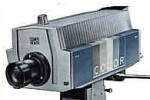
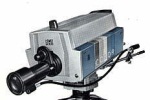
RCA TK42 – 43 Series:
Bobby Ellerbee: 1 TK42
Julian Burke: 2 TK42, 1 TK43
Chuck Pharis: 1 TK42
Allan Weiner *: 1 TK42 , 2 TK43s
Tom Long: 1 TK42
Jay Ballard: 2 TK42s
WAVY-TV: 1 TK 42
UCLA: 2 TK42s, 1 TK 43
DC Video: 1 TK42 with chain
Ed Sharpe: 1 TK42
Total = 17 (Running Total = 157)
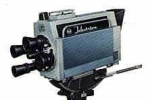
RCA TK60:
Bobby Ellerbee: 2 TK60s
VM – J.F.K. Library: 1 TK60 (from Paul Beck with thanks to the SSM)
MBT: 9 TK60s
Chuck Pharis: 5 TK60s
Jay Ballard: 1 TK60
Allan Weiner *: 1 TK60
UCLA: 2 TK60
Julian Burke: 1 TK60
DC Video: 1 TK60
SSM: 1 TK60 (at Kennedy Library)
Robert Voll: 2 TK60
Jan Lowery: 1 TK60
Bob Blauvet: 1 TK60
Brian Summers (UK): 1 TK60
Jim Bragg: 2 TK60s
HFH: 4 TK60s
Ed Sharpe: 2 TK60
James Patterson: 1 TK60 (Australia, oldtvgear.com)
Total = 38 (Running Total = 195)
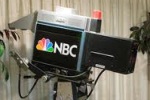
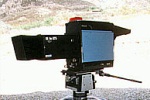
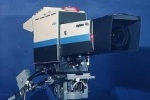
RCA TK 44 (left) – TK45 (center) – TK46 (right) Series:
Bobby Ellerbee: 2 TK44s, 2 TK46s
VM – Bob Meza: 1 TK44 (Bob was the last engineer at NBC Burbank to work on the 44s)
Jon Lessa: 3 TK44s
MBT: 3 TK44s, 4 TK45s
VM – WLIO-TV: 1 TK44
Chuck Pharis: 3 TK44s, 2 TK45s, 1 TK46
Jay Ballard: 3 TK44s
VM – Lytle Hoover: 1 TK44 (curator of the Virtual Museum at oldradio.com)
Ed Sharpe: 2 TK44
DC Video: 2 TK45s, 5 TK46s
PIC: 1 TK44
Ronald Purtle: 1 TK45
Jan Lowery: 1 TK44
UN: TK44B (serial # 08043; original owner WOWT-TV, Omaha)
John Bolin: 2 TK44s
Jim Bragg: 1 TK44
HFH: 4 TK44s, 2 TK45s
Joe LaRe’: 1 TK44
James Patterson: 1 TK45 (Australia, oldtvgear.com)
VM: 1 TK44, Dennis Lamb
VM: 1 TK46, Carl Bergquist
Total = 52 (Running Total = 250)

RCA TK47:
Bobby Ellerbee: 1 TK47
VM – Lytel Hoover: 2
Ed Sharpe: 3
Chuck Pharis: 2
Jay Ballard: 11
Lou Gordon: 4
Tom Long: 1 TK47C Model
MBT: 5
Jan Lowery: 1 TK47
Brian Summers (UK): 2 TK47
John Bollin: 1 TK47
Jim Bragg: 2 TK47
HFH: 4 TK47s
Jodie Peeler: 1 TK47 with chain (formerly of KCET-TV)
Total = 40 (Running Total = 290)
![]()
RCA 1939 Iconoscope:
MRT: 1 1939 Studio Camera, (Model MI-21081-A) Very rare field camera, recently acquired and on display.
ETF: 1 1939 Field Camera. A very rare and historic camera. Steve McVoy has had this a few years and a great page of pre 1945 cameras on his site can be seen by clicking here
Total = 2 (Running Total = 292)
End of RCA Cameras: counting 292 known, remaining RCA studio cameras.
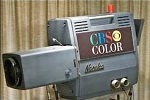
Norelco PC60 – PC70:
Bobby Ellerbee: 1 PC60, 2 PC70s
NEW: 4 PC70s (CBS – Cronkite Studio cameras)
MBT: 4 PC60s, 6 PC60-70s, 4 PC70s (+ 1 PCP 70)
Chuck Pharis: 2 PC-60s, 4 PC-70s
UCLA: 1 PC 70
Allan Weiner *: 1 PC70 + 2 PCP 70s
Ed Sharpe: 3 PC70
Martin Perry: 1 PC60
HFH: 10 PC70s
DC Video: 2 PC70s with chains
Julian Burke: 1 PC70
Total = 48 (Running Total = 340)
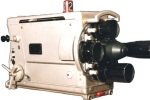
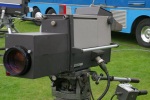
Marconi: Mark V – Mark VII
Bobby Ellerbee: 1 Marconi Mark IV, 1 Mark VII (Sesame Street, Tele-Tape Productions)
Guy Spiller: 2 Mark VII
Chuck Pharis: 2 Mark IV
UN: 1 Mark VII, original owner KOUN-TV at UN
Chuck Conrad: 1 Mark IV head with 3 ccus (WFAA/Dallas, Kennedy – Oswald)
James Patterson: 1 mint condition Mark IV, 1 Mark VIII, Melbourne, Australia…OldTVGear.com
Dicky Howett: 1 Mark II, 1 Mark III (see all his cameras in the Collections section)
Golden Age Television Recreations: 1 Mark ll, 10 Mark llls, 6 Mark IVs, 2 Mark Vs and 7 Mark Vllls
(this is the top UK TV prop house owned by Dicky Howett).
Special Note: In a conversation with Dicky Howett, he estimates there is 1 more Mark IV in Australia, 2 more in New Zealand and 4 more in British museums, including the BBC, for 7 more surviving Marconi cameras.
Total Mark ll is 5 worldwide Total Mark llls is 11 worldwide
Total Mark IVs is 16 worldwide Total Mark Vll is 11 worldwide
Total = 48 (Running Total = 388)
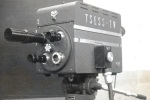
DUMONT:
HFM: 1930s era Iconoscope camera from WWJ TV
Alan Weiner: 4 TA-12 complete chains
Chuck Pharis: 1 124B studio camera with chain, 1 Electrocam with film camera attached
PCI: 1 studio camera
SSN: 1 studio camera chain
UN: 1 Pickup head 5098C and Viewfinder 5099B, original owner KOLN-TV, Lincoln
Chuck Conrad: 5095A IO (thought to be from WFAA / KBTV Dallas)
South Carolina State Museum: 2 studio cameras (one ex-WNOK-TV, with chain; one ex-WCSC-TV)
Total = 13 (Running Total = 401)

General Electric:
Bobby Ellerbee: 1 PE 350, 1 PE 400
SM: 2, 1930s era Iconoscope cameras from WRGB-TV
Ronald Purtle: 1 PE 250
DC Video: 1 PE 350 with chain
Chuck Pharis: 3 PE 250, 2 PE 11 (5-lens cameras)
UN: 1 I/O camera (no model) from 1953, original owner NTV network stations, KHOL and KHGI
UN: 1 color (no model) 1967, original owner KOLN-TV
ETF: 1 PC 11 I/O model, 1 PE 250
Martin Perry: 1 PE 250, 1 PE 400, 1 PE 15 (The PE 400 may be the first color camera used in the Goodyear blimp)
Chuck Conrad: 1 4PC 121 A1 IO (KRLD Dallas TX), 1 4PC 14 A2 Videcon (SMU, Dallas) chalkhillmedia.org
Julian Burke: 1 PE 250, 1 PE 350
Eduardo Suarez: 1 PC 11B
Total GE cameras = 22 (Running total = 423)
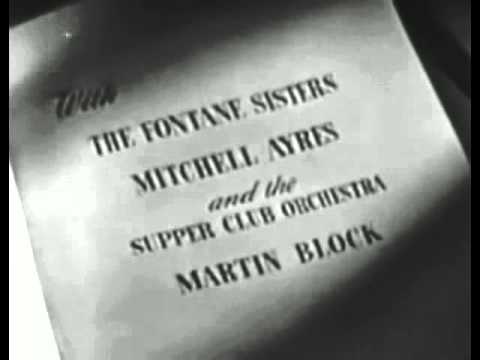
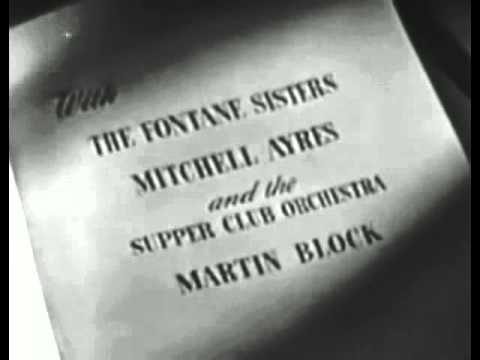
Television’s 1st Prime Time Season; 1948…With My Detailed Notes
Television’s 1st Prime Time Season; 1948…With My Detailed Notes
This is just amazing…what you will see here are some of the first shows to run in the first real TV season, with all four networks in operation…NBC, CBS, ABC and Dumont. Back then, “networks” with live feeds, were basicly a handful of stations in the northeast, with outlying affiliates able to take shows via kinescope, which is how these clips survived. Oh, and the only network programming was from 7 – 10 PM.
Live network coverage was about to expand though, as an NBC VO announces at the start of this, that the midwest network links will be open and operating by Christmas, 1948.
“The Gay Nineties” show was on ABC on Wednesday nights from 8 – 8:30.
At 1:50 we see some of an early “Texaco Star Theater” with Milton Berle from NBC’s newly converted Studio 6B. This was the first show to come from 6B after it was converted from radio to television June 8, 1948. The woman with the great laugh is Milton’s mother who was at every show.
Just after that is “The Ed Wynn Show” which NBC did as a remote from The New Amsterdam, before it was converted in 1951.
At 3:32, “The Admiral Broadway Revue” was the first television show produced by Max Leibman, and starred Sid Caesar and Imogene Coca…this is the forerunner of “Your Show Of Shows”, and both were done at The International Theater at 5 Columbus Circle.
More rare footage starts at 4:44 with the intro of “The Fireball Fun For All” starring Olsen and Johnson. This ran one season, and was one of the first shows to come from CBS Studio 52. The assistant director is the legendary CBS director Ralph Levy in his second ever TV job. Levy went on to direct Jack Benny, Burns And Allen and the Lucy pilot. Levy’s first AD job was on the first show done at Studio 52, a summer show called “The 54th Street Revue” that ran eight weeks.
There’s more history at 6:10…”The Chesterfield Supper Club” starring Perry Como, was the first television show to broadcast from NBC Studio 6A. The studio was not converted officially till May 19, 1950. When this was shot, 6A was still a radio studio with a three camera remote unit and very few lights, which you notice here.
More history at 6:50! This is “The Fred Waring Show” from CBS Studio 41 at Grand Central, and this aired on Sunday night, just after “Toast Of The Town” with Ed Sullivan, which then came from Studio 51, The Maxine Elliott Theater.
Remember the opening announcement about the midwest network link up? “Your Show Time” had premiered on NBC’s East Coast stations in September 1948, and began to include NBC’s Midwest stations on January 21.
“Armchair Detective” was a Dumont show done at WABD.
At 9:06 notice the producer title…William Boyd. Boyd was Hopalong Cassidy, and a very smart showman! This show was an hour long and aired on NBC Friday nights at 8, starting in 1949.
“The Lone Ranger” debuted on ABC in September of 1949 and aired at 7:30 Wednesday nights.
Remember the Hungry Jack Biscuit commercials with the “Hungry…Hungry Jack” call? Here’s where it came from…the opening of “The Aldrich Family” at 10:23. This was on NBC at 7:30 Sundays.
At 10:55, one of television’s biggest shows appears…”The Goldbergs”, which was on CBS, and came from Studio 42 at Grand Central. This started in 1949, and aired Monday nights at 9:30.
Just after that is another huge CBS show, “Mama” which also started in 1949 and aired Friday nights at 8, against “Hopalong Cassidy” on NBC.
“The Ruggles” began on ABC, November 3, 1949 – a month after the radio hit “The Life of Riley” had moved to television on NBC, and interestingly, that is the next clip…but if you were expecting William Bendix as Riley, surprise…Riley is played by Jackie Gleason! This was his first starring role.
At 13:10 we see the open for “Suspense” which aired on CBS from ’49 till ’54. It was on Tuesday night opposite “The Life Of Riley”.
Finally, the last clip is from “Studio 1”. It was a big hit, and an important early anthology series on CBS, which debuted in September of 1948, and ran 10 seasons ending in 1958. Enjoy and share! -Bobby Ellerbee
#t=514″ target=”_blank”>https://www.youtube.com/watch?v=H6sOTBtcCcA #t=514
Some of the shows that began their run in 1948 and 1949.
Source
Starting From Scratch…The Earliest CBS Grand Central Studios Images
In the fall of 1939, CBS began work on the area they had chosen to become their premier television studio facilities. When it was all said and done, Studio 41 and 42 were created in this space you see below, in this one gigantic hall. Studio 41 was 44 x 60, and 42 was 44 x 76, and they were divided by a removable wall. The control rooms were built at the outer-wall ends of each of these production spaces.
Not to confuse you, but CBS also referred to these control rooms as studios, mostly because of their ability to operate independently of the attached production space in that they could take feeds from any source and could send out images from film and telecine units located there. Studio 43 (a control room) was at the end of Studio 41 and (control room) Studio 44 was at the end of Studio 42. Later, like in the early 50s, the space above the control rooms was pressed into service as a second story with telop, telecine and film chains upstairs and expanded control panels in the downstairs area.
As you look, keep in mind the larger set of windows are on the outside wall, and the smaller arched windows on the opposite side are above an internal hallway. When the larger windows are on the right, you are looking in the direction of Studio 41 and when they are on the left, your view is tword Studio 42. When the sound paneling on the walls goes up, the windows are no longer visible.
There will be more detail on the photos, but before CBS took over, this had been the offices of the Grand Central Terminal’s Federal Credit Union, that served the workers of the New York Central Railroad. A lot of television history was made here, and here is the starting point. -Bobby Ellerbee
The photo at the top of the page shows where the Studio 41 control room will be built. All of the railing and stairs will come down and the CR will be built in the lower opening. The small office with the many windows will remain intact as the film projection room and film will be projected directly into an Iconoscope camera suspended on a rolling track in the control room. You can see the open space above the control rooms that will be the second story rooms in the early 1950s.
Above is the Studio 42 end with another set of small offices that will be torn out to construct the control room for 42. Notice that camera lights are already here, even before construction has started on this end. As you will see soon, camera work was being done in the studio, and I think Studio 41’s control room was the first to be built and operative.
Above, we are looking from where the Studio 42 control room will be, toward the future Studio 41 control room area. Notice the outside wall is on the right, and the hallway that that access this space with doors is on the left.
Above, we are looking toward the future Studio 42 control room, from the Studio 41 control room area, with the internal hallway on the right.
Above, Studio 41 control room with light grid hangers going in.
This is the first ever sighting of electronic cameras in use at CBS. Photo is dated September 1, 1939. This is an RCA Iconoscope camera is broadcasting test images of live subjects over the newly operational transmitter at The Chrysler Building. Notice these are the same lights that we saw here a month or so before while construction on the Studio 41 CR was going on. The walls are all covered with sound proofing now too.
In the next 2 photos below, we can see a door to the hallway on the left wall, which makes this shot in Studio 41 with the CR behind the large set in the back.
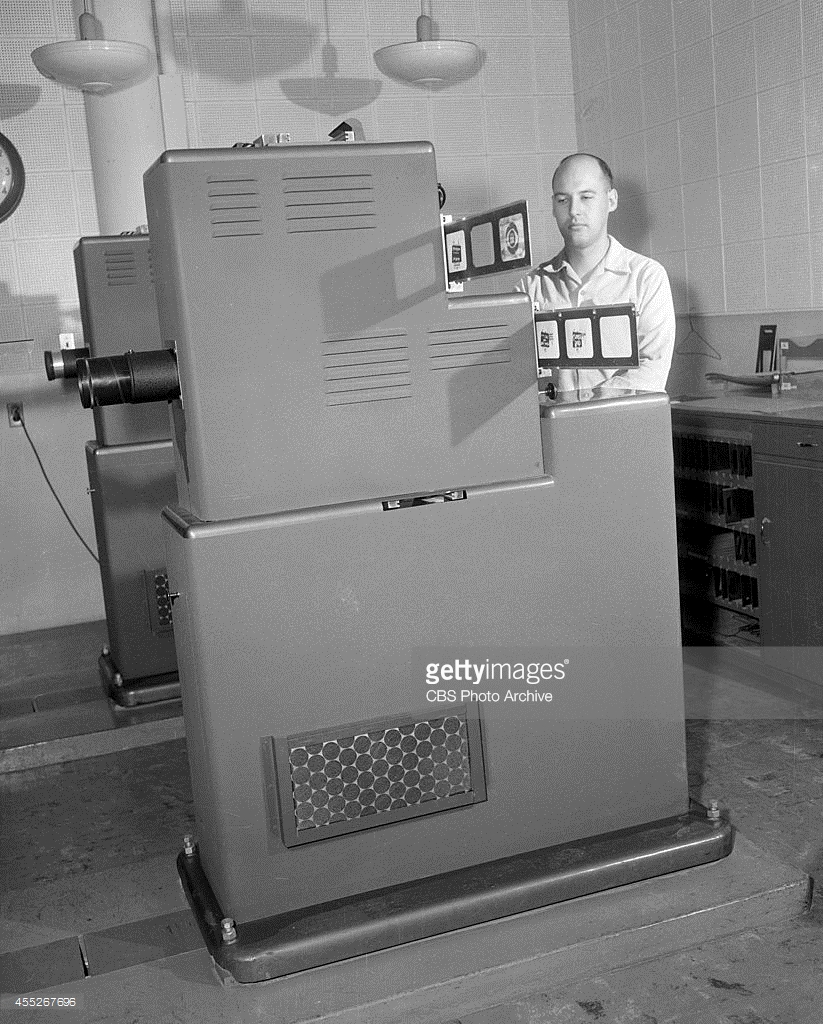
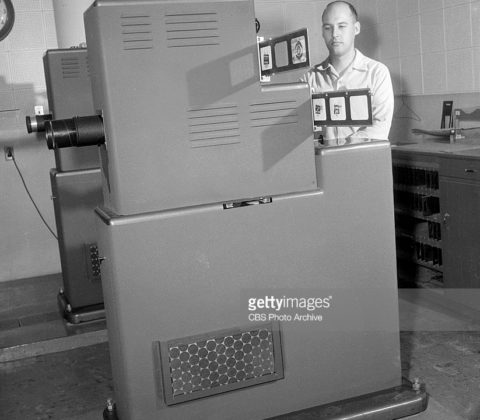
Gray Research Telop Machine, Television’s First Optical Projection System
Thanks to Val Ginter in NYC, here is a rare copy of the 1953 Gray catalog with a price list at the end. This machine was able to televise opaque cards, which was the forerunner of transparent slides. It also had add on features that would allow a news type horizontal ticker scroll across the bottom of the screen (on real ticker tape) and a vertical scroll for credits. All the networks depended on them heavily for station breaks and promos, and they were also widely used at local stations.
When it comes to the lower third of the screen, this was the first apparatus that could scroll text there. As you will see, it was an available accessory for use on the Gray Telop machines and the horizontal ticker crawl was done with 8MM film.
BUT! Before we go to the finished product, here is the CBS and NBC prototypes of this machine! The “CBS Shadowbox” design (below) was the version that Gray licensed to manufacture from CBS. This three-function machine allowed a live camera to shoot into the box and see, with the aid of moving mirrors, photo images, title cards and “rolling credits” on a drum. With no fader controls on the switching console in the control room, live dissolves could be done here manually with mirror movements and fading light sources in each of the three sections.

These two photos below show what I believe to be the next version of the baloptican projection element of the CBS prototype before licensing their technology to Gray. Thanks to Harry Moore and his Early Television and Television Hobby Experimenters Facebook site.
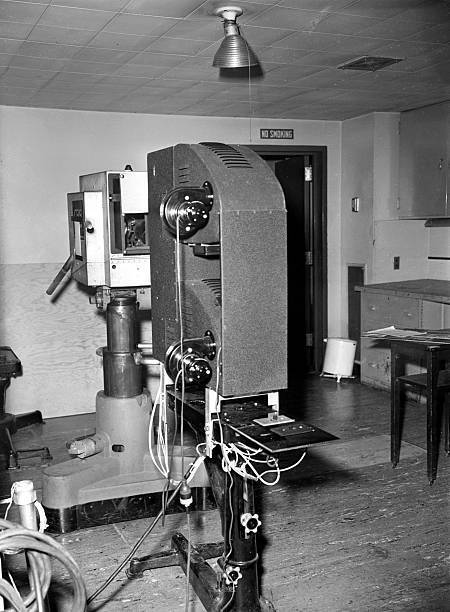
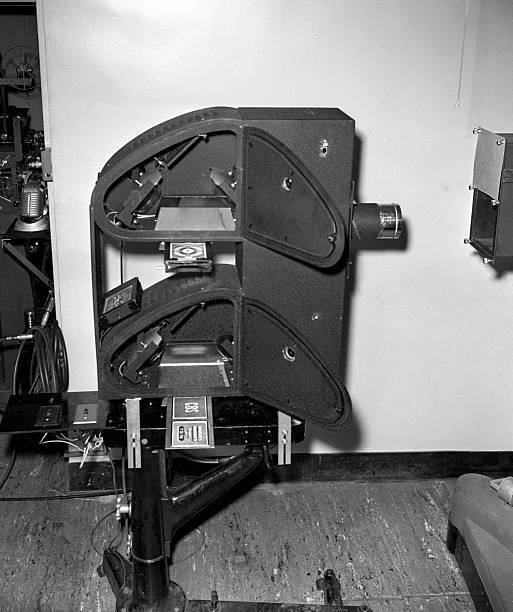
Below is the middle element of NBC’s three element version which was called the “title frame optical mechanical dissolve machine”.
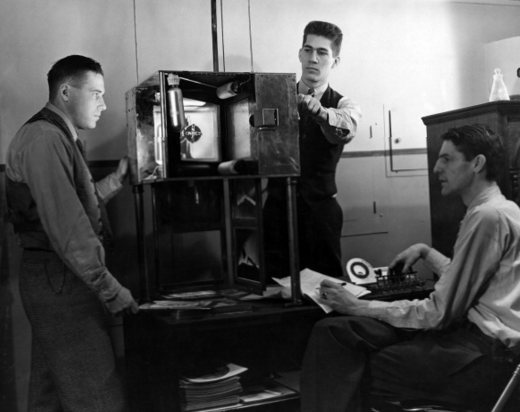
This brochure features images and a price list from Gray from 1953. The cost of the top-of-the-line Telop I was $3500…in today’s money, that’s over $31,100. CBS had a half dozen of these in their Grand Central headquarters. I’m pretty sure NBC and ABC used these too. There were two smaller, less expensive models for local stations as well and these were marketed mostly as production aids for creating spots, but at the network level, they were the main mechanisms for promos and billboarding upcoming shows and it was all done live during the breaks. The alternative would have been the RCA 35MM slide drums in a telecine chain, but I don’t know if they had those in the early 50s.


